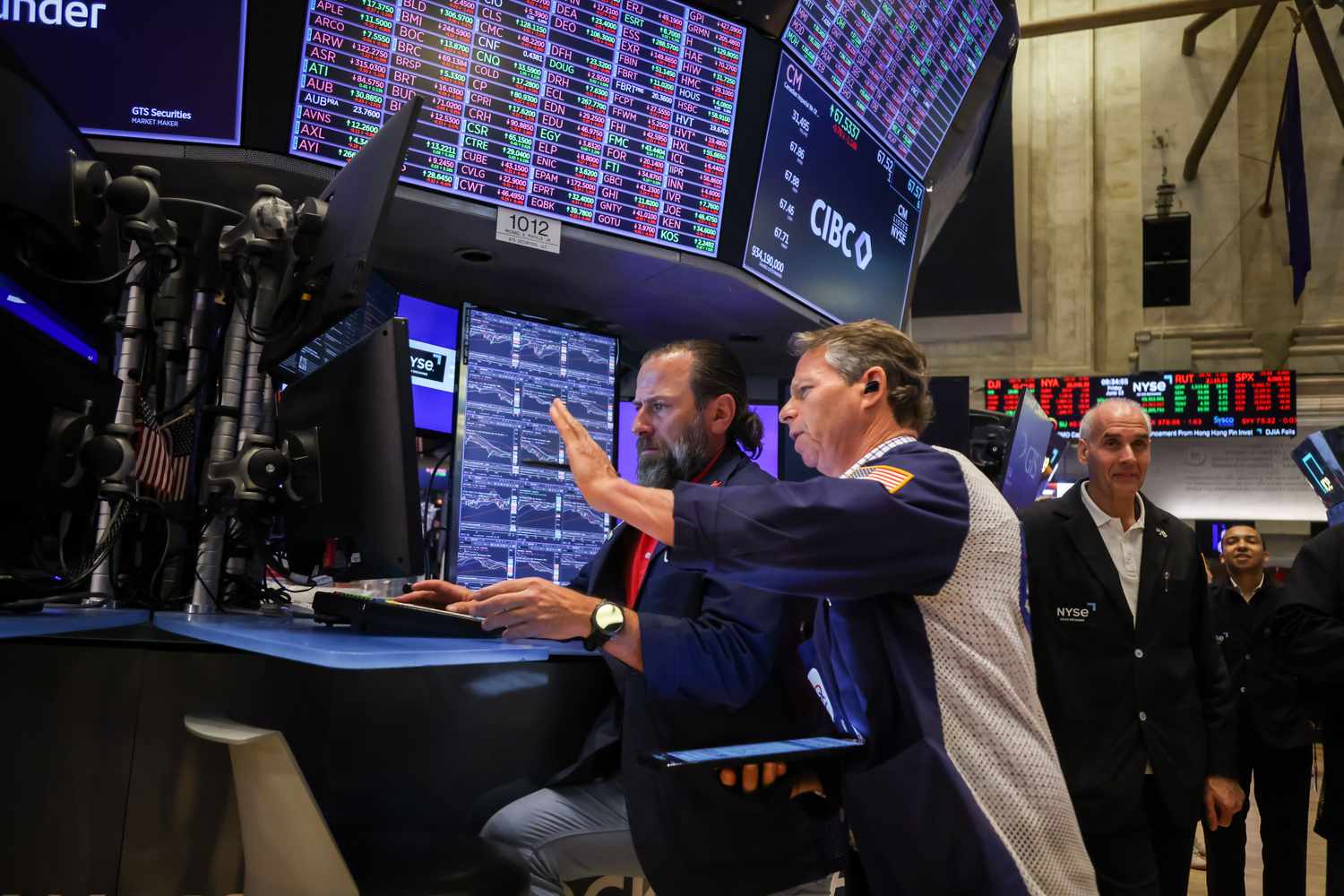Market Sanguine About Middle East Tension—Is That Normal?
21 minutes ago
Investors were sanguine on Monday about the risk of conflict between Israel and Iran spiraling and causing an oil-supply shock that would materially affect the global economy.
Even amid volatile trading on Friday, there was plenty of evidence that investors weren’t that concerned about the conflict spiraling out of control. High yield credit spreads increased just 2 basis points, a sign of modest risk aversion, and the MSCI World Index closed just 1% off its all-time high.
It’s not out of the ordinary for markets to quickly shrug off major geopolitical events. The S&P 500 tends to fall about 6% in the three weeks after a geopolitical shock before recovering all of those losses in the following three weeks, according to a recent survey by Deutsche Bank analysts Parag Thatte and Binky Chadha. And with equity positioning historically low by their measure, a bigger sell-off was even more unlikely today.
Geopolitics has had a sustained impact on the stock market only when it’s affected the real economy, whether by slowing growth or lifting inflation, Deutsche Bank analyst Henry Allen said in a note on Monday. There are only a few examples of oil shocks having a meaningful impact on stocks, including the oil embargo of the 1970s and Iraq’s invasion of Kuwait in 1990.
The most recent example of a geopolitical disruption to the stock market is Russia’s invasion of Ukraine in 2022, which bears some troubling resemblance to today. Inflation was already running above target when Russia’s invasion drove oil prices up more than 30% in a matter of weeks. The oil- supply shock fueled an acceleration of already-elevated inflation, likely forcing central banks to raise interest rates faster and higher than they would have otherwise, Allen’s report said.
Inflation has moderated considerably since hitting a 40-year high in June 2022. Consumer prices increased 2.4% year-over-year in May, just slightly above the Federal Reserve’s 2% target. However, President Donald Trump’s tariffs threaten to raise prices, and their inflationary impact could be exacerbated by escalation in the Middle East.
“The inflation risk really matters, because the problem with higher inflation is it will restrict central banks from cutting rates, as is currently priced,” Allen wrote. The majority of investors are currently pricing in rate cuts of at least 100 basis points by the end of next year. Resurgent or sticky inflation would leave the Fed little room to cut interest rates if tariffs and high oil prices weighed on growth or the labor market.
AMD Soars as Piper Sandler Upgrades After AI Event
1 hr 4 min ago
Advanced Micro Devices (AMD) shares popped Monday as Piper Sandler analysts raised their price target for the stock coming out of the chipmaker’s “Advancing AI” event.
Piper raised its target to $140 from $125 and maintained an “overweight” rating for AMD stock. Shares of AMD were up more than 9% at around $127 in recent trading, pacing S&P 500 advancers.
The analysts came away “enthused” by the firm’s newly unveiled Helios server rack architecture, which it called “pivotal” for the growth of AMD Instinct GPUs. Helios will combine next-generation AMD MI400 chips into one larger system, the company said, and is expected in 2026.
Alex Wong / Getty Images
AMD highlighted its partnerships with ChatGPT maker OpenAI, Meta Platforms (META), Oracle (ORCL), Microsoft (MSFT), and others at the event. Bank of America analysts believe there’s another high-profile partner announcement to come: Amazon (AMZN).
Amazon Web Services (AWS) was “a key sponsor for the event,” BofA said. However, AWS typically uses its own events to announce new engagements, making a future reveal likely, the bank added.
BofA maintained a “buy” rating and price target of $130 following the event. For comparison, the analyst consensus price target from Visible Alpha is about $124.
Sarepta Therapeutics Plunge as 2nd Patient Dies Taking Drug
1 hr 51 min ago
Shares of Sarepta Therapeutics (SRPT) plummeted after the biotech company reported a second patient taking its Elevidys drug for Duchenne muscular dystrophy died of acute liver failure (ALF).
Sarepta said both of those who died had non-ambulatory Duchenne, and it has temporarily suspended shipments of Elevidys for such patients. In addition, it will “immediately convene an independent group of leading experts in Duchenne and liver health to consider an enhanced immunosuppression regimen for ELEVIDYS.”
The company is also pausing a study evaluating Elevidys’ efficacy for older ambulatory and non-ambulatory patients with Duchenne.
Louise Rodino-Klapac, chief science officer and head of research and development at Sarepta, said the firm was taking “immediate, decisive steps to better understand and mitigate the risk of acute liver failure” in those taking Elevidys.
Back in March, Sarepta shares also sank after it announced the first ALF death of a patient on Elevidys. At that time, the company noted that acute liver injury was a possible side effect of the treatment, and was gathering information and planned to “update the prescribing information to appropriately represent this reported liver failure event and any additional monitoring requirements.”
TradingView
Shares of Sarepta were recently down 45%, trading at their lowest level in nearly a decade.
Meta Climbs as Company Set to Launch Ads on What’s App
3 hr 3 min ago
Meta Platforms (META) shares climbed Monday as the social media giant said it’s introducing paid advertising to WhatsApp, in a move that could expand its revenue streams.
In a reversal of WhatsApp’s longtime “no ads” mantra, Meta said Monday that it’s bringing channel subscriptions, promoted channels, and ads to its WhatsApp Updates tab, which the company said attracts about 1.5 billion users daily. The new features are expected to be rolled out globally over the next few months in an attempt to boost Meta’s ad revenue.
Separately, Oppenheimer analysts raised their price target for the stock to $775 from $665 in a Sunday research note, citing Meta’s improving ad market outlook. The analysts suggested Meta could even see further upside with “higher than expected monetization driven by Instagram, Stories, and video.”
TradingView
Meta shares were up 2.5% at around $700 in recent trading.The stock has added nearly a fifth of its value since the start of the year, making it the best-performing member of the Magnificent Seven in 2025.
US Steel Jumps as Nippon Steel Set to Complete Acquisition
4 hr 36 min ago
United States Steel (X) shares surged Monday, as the Pittsburgh-based company’s takeover by Japan’s Nippon Steel looks set to close following approval by President Donald Trump.
Trump issued an executive order on Friday green lighting Nippon Steel’s takeover of U.S. Steel after the companies signed a national security agreement, which included the issuance of a so-called golden share to Washington. The companies didn’t elaborate on what the golden share would entail.
In a post on X over the weekend, Commerce Secretary Howard Lutnick said the golden share “has powerful terms that directly benefit and protect America, Pennsylvania, the great steelworkers of U.S. Steel, and U.S. manufacturers that will have massively expanded access to domestically produced steel.” The golden share prevents U.S. Steel from many actions without the president’s approval—such as moving the headquarters out of Pittsburgh, transferring jobs outside the U.S., or changing its name, Lutnick wrote.
The national security agreement also provided for approximately $11 billion in new investments to be made by the companies by 2028. Former President Joe Biden blocked the $14.1 billion takeover by the Tokyo-based steelmaker in the final days of his presidency, citing national security concerns.
The companies said they have received all the needed regulatory approvals, and “the partnership is expected to be finalized promptly.”
U.S. Steel shares were up 5% in recent trading. The stock has gained about 60% since the start of 2025.
Boeing Levels to Watch After Last Week’s Slide
5 hr 29 min ago
Boeing (BA) shares inched higher Monday morning after slumping to end last week following news that one of the company’s aircraft was involved in an Air India plane crash on Thursday.
While air safety experts have said that at this time there is no reason to think a manufacturing or design problem caused the incident, it comes as the aircraft manufacturer faces heightened scrutiny over its production processes following several mishaps involving its planes, including a door plug detaching in midair on an Alaska Airlines 737 Max 9 flight in January last year.
Boeing shares fell 4.8% on Thursday and dropped another 1.7% on Friday. The stock still trades about 13% higher since the start of the year. In recent months, the shares have been boosted by optimism that the company could be a beneficiary in a long term trade deal with China and Beijing’s withdrawal of a ruling imposed in early April that barred the country’s airlines from taking delivery of Boeing planes.
Boeing shares staged a news-driven breakdown from a rising wedge pattern in Thursday’s trading session, potentially setting the stage for a deeper retracement. The selling, which occurred on the highest volume since last October, coincided with the relative strength index falling toward its neutral threshold, signaling accelerating downside momentum.
Investors should watch crucial support levels on Boeing’s chart around $187 and $163, while also monitoring vital resistance levels near $218 and $245.
The stock was up 0.7% at just under $202 in recent trading.
Read the full technical analysis piece here.
What to Expect from Fed Meeting This Week
6 hr 41 min ago
The Federal Reserve is likely to stick to its “wait-and-see” mantra, setting it on a collision course with the president.
The Federal Reserve is widely expected to hold its key interest rate steady when the central bank’s policy committee meets Wednesday, possibly provoking more wrath from President Donald Trump, who has repeatedly demand the Fed, which is not under direct control of the White House, cut its benchmark interest rate by an entire percentage point.
Financial markets are pricing in nearly a 100% chance the Fed will leave the rate unchanged this week, according to the CME Group’s FedWatch tool, which forecasts rate movements based on Fed funds futures trading data.
Al Drago / Bloomberg / Getty Images
In recent weeks, Fed officials have said they’re reluctant to lower interest rates from their current elevated levels because they’re concerned Trump’s tariffs will reignite the high inflation that has fallen to within shooting distance of the Fed’s target of a 2% annual rate, after surging in the post-pandemic era. For his part, Trump has frequently browbeaten the Fed for not having cut rates this year, going so far as to call Fed Chair Jerome Powell a “numbskull”.
A lower fed funds rate could boost the economy and encourage job creation, but it could also take some of the downward pressure off inflation.
Fed officials have been under a communications “blackout” over the past week in advance of the meeting, but before they went silent, members of the Federal Open Market Committee said they wanted to see how the economy responded to Trump’s tariffs before making any policy moves.
The tariffs pose a dual threat to the Fed’s dual mandate to keep inflation low and employment high: not only could the import taxes push up prices, but they could hurt the economy, potentially pushing up unemployment. If inflation proves the greater threat, the Fed could keep interest rates higher for longer, or alternatively, could cut rates to rescue the economy if the job market starts to crumble.
Recent economic data has showed the job market holding steady and inflation staying cool, giving the Fed more reason to bide its time, economists said.
“No FOMC official has been advocating for a change in policy, so the decision to hold should be easy,” Michael Feroli, chief U.S. economist at JPMorgan Chase, said in a commentary.
The fed funds rate is the Fed’s main tool for carrying out monetary policy and influencing the economy. The rate affects interest rates at which banks lend money to one another, which influences how much interest they charge for car loans, credit cards, and other debt.
The Fed cut the rate to near zero to support the economy with easy money during the pandemic, and cranked it up to a two-decade high starting in 2022 to counteract a surge of inflation, holding it there until late 2024. Last year, the Fed began cutting rates because inflation was cooling, but has kept the rate flat since December after Trump’s election shook up the economic outlook.







